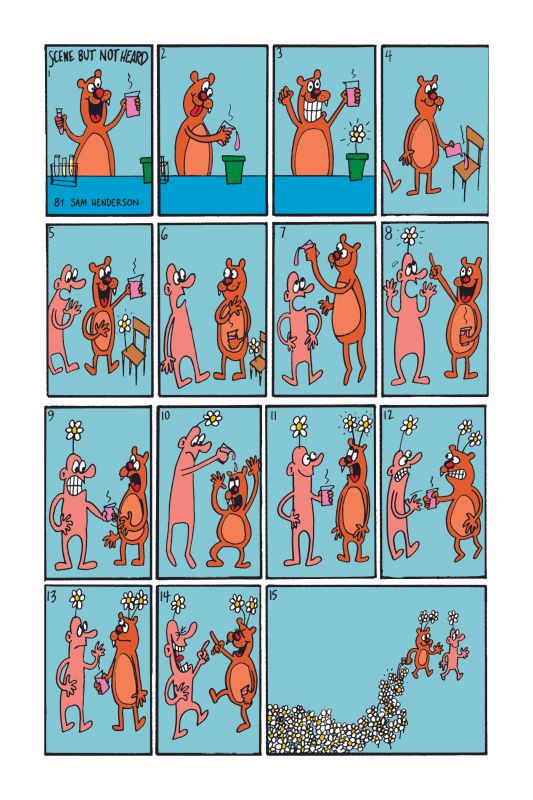 I'm in it for my work in Nickelodeon magazine and my tenure on SpongeBob Squarepants. People who check out this blog frequently know I do both kids' work and work “blue”. The one good thing about Nickelodeon
being canceled a few years ago is I no longer have the problem at conventions of children walking by my table, recognizing my art, and having to be told they can't buy the comics because of drawings of penises or whatever. Now the kids' entertainment I do is mostly drawn by others in a different style, and those kids are now grown up and able to buy whatever they damn well please.
I'm in it for my work in Nickelodeon magazine and my tenure on SpongeBob Squarepants. People who check out this blog frequently know I do both kids' work and work “blue”. The one good thing about Nickelodeon
being canceled a few years ago is I no longer have the problem at conventions of children walking by my table, recognizing my art, and having to be told they can't buy the comics because of drawings of penises or whatever. Now the kids' entertainment I do is mostly drawn by others in a different style, and those kids are now grown up and able to buy whatever they damn well please.Here is the interview I did for it where I'm not the pottymouth you all know and love:
name: Sam Henderson
age: 43
gender: M
from: Woodstock,NY
Where do you reside now: between New York, NY and Woodstock, NY
current job: freelance
comic books you've created or worked on: A series called The Magic Whistle, feature called 'Scene But Not Heard' for Nickelodeon 1993-2009, writer for SpongeBob Squarepants in 2001.
What was your first or favorite comic when you were younger?
I was into MAD and if a new one wasn't out I'd get one if its competitors. My mother worked for the local paper so I'd see all the funnies through that. Like most eventual cartoonists I especially liked Peanuts. My father saved all sorts of things most people throw away so as a result I saw all the comics he collected in the fifties like ECs before they were reprinted multiple times. From kindergarten to twelfth grade I'd rush home to see animation from the major Hollywood studios 1940-1960. A local store didn't mind me buying underground comics as a kid.
When did you know you wanted to make comics?
After seeing the above I decided that's what I wanted to do. I assumed everything I saw was known in every household and anybody who did a comic was famous.
What kind of things inspire your comic book creations?
Life around me. Like when I see my fan out of the corner of my eye I think of situations that would involve fans. Right now I'm working on a longer comic about my childhood and spend enough time in my hometown to remember specific locations from more than thirty years ago.
What tools do you use to create your comics?
Mostly Microns, which are kind of a combination of felt tips and rapidographs, You don't have to clean them like rapidographs, and they don't bleed or change point sizes like with markers.
What are great ways for kids to create comics, right now/today?
Keep a sketchbook with you so when you come up with an idea, you can execute it. The final comic is a more legible version of what you've done before. Computers are good now to scan the work and make files.
How do you use technology to create comics?
In high school and college, I used to make a xerox comic and mail it to 30-50 people, now you can put it on the internet and get feedback right away without having to buy stamps or go to the post office. You can also instantly fix it if necessary. If you're messy like I am, you can Photoshop it to clean up any smudges or erasures, and forget ever having to do color on paper unless you want to.
Why is telling a story with comics important to you?
For me, it's easier to communicate an idea using words and pictures without having to use either of those methods alone. It's also something possible to do without having to have people cooperate exactly the way you want them to.
how did making comics prepare you for a job writing for Spongebob SquarePants
When I worked on Spongebob, it was from seeing my comics that they decided they wanted to use my sense of humor and aesthetics.
How do you use social media to create or promote your work?
Facebook is good for publicity and get feedback so you'll know what people think. There have been times when I've redrawn something because of what somebody suggested and it turned out to be a better solution. It's easier to promote or show what your working on without having to pay money or wait until you can get together with somebody.
And here's a sample of Scene But Not Heard that was used in the book.













































































No comments:
Post a Comment